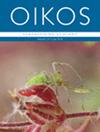The thermal sensitivity of growth and survival in a wild reptile with temperature‐dependent sex determination
IF 3
2区 环境科学与生态学
Q2 ECOLOGY
引用次数: 0
Abstract
The Charnov‐Bull hypothesis is the leading explanation for the evolution of environmental sex determination (ESD), which includes temperature‐dependent sex determination (TSD), the most common form of ESD. Charnov‐Bull predicts a sex‐by‐incubation temperature interaction for fitness, matching offspring sex with thermal conditions that increase parental fitness. However, there is no general explanation for how the sex‐by‐temperature interaction arises. Two competing explanations for the interaction lie in the survival to maturity hypothesis (SM) and the Trivers–Willard extension (TW). Under SM, the sex that matures later is produced under optimal incubation regimes as the late‐maturing sex accrues more mortality by maturation, while TW suggests that males are always produced under optimal incubation regimes as male mating success is more sensitive to condition (general health, vigor) than female fecundity. In a system where females mature later than males, as in the painted turtle野生爬行动物的生长和存活对温度的敏感性与性别决定有关
查诺夫-布尔假说是环境性别决定(ESD)进化的主要解释,其中包括温度依赖性别决定(TSD),这是最常见的ESD形式。恰尔诺夫-布尔假说预测了性别-孵化温度对适应性的相互作用,即后代性别与增加亲代适应性的温度条件相匹配。然而,对于性别与温度之间的相互作用是如何产生的,目前还没有一般性的解释。对这种相互作用的两种相互竞争的解释是存活到成熟假说(SM)和特里弗斯-威拉德延伸假说(TW)。在存活到成熟假说(SM)中,成熟较晚的性别是在最佳孵化机制下产生的,因为成熟较晚的性别在成熟时会积累更多的死亡率;而在存活到成熟假说(TW)中,雄性总是在最佳孵化机制下产生的,因为雄性交配成功率对状态(总体健康状况、活力)比雌性繁殖力更敏感。在一个雌性比雄性晚熟的系统中,如彩龟(Chrysemys picta),SM 和 TW 对孵化温度对幼龟存活率的影响产生了相反的预测。我们在雌性促进温度(28 ± 3 °C)或雄性促进温度(25 ± 3 °C)下孵化画眉龟卵,然后将孵出的幼体放归其出生池塘。我们采用贝叶斯捕获-标记-再捕获方法,跟踪幼体在两个生长季节的存活情况。我们发现,在较低温度下孵化的个体的双周存活率降低了2%,这为SM提供了微妙的支持。孵化处理并不影响生长。像这样的大规模野外实验对于了解TSD的进化很有必要,我们强调了成功实施此类实验的一般原则。
本文章由计算机程序翻译,如有差异,请以英文原文为准。
求助全文
约1分钟内获得全文
求助全文
来源期刊

Oikos
环境科学-生态学
CiteScore
6.20
自引率
5.90%
发文量
152
审稿时长
6-12 weeks
期刊介绍:
Oikos publishes original and innovative research on all aspects of ecology, defined as organism-environment interactions at various spatiotemporal scales, so including macroecology and evolutionary ecology. Emphasis is on theoretical and empirical work aimed at generalization and synthesis across taxa, systems and ecological disciplines. Papers can contribute to new developments in ecology by reporting novel theory or critical empirical results, and "synthesis" can include developing new theory, tests of general hypotheses, or bringing together established or emerging areas of ecology. Confirming or extending the established literature, by for example showing results that are novel for a new taxon, or purely applied research, is given low priority.
 求助内容:
求助内容: 应助结果提醒方式:
应助结果提醒方式:


